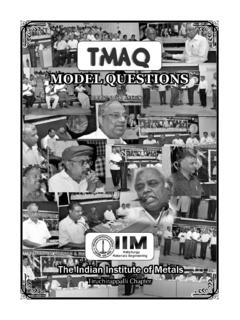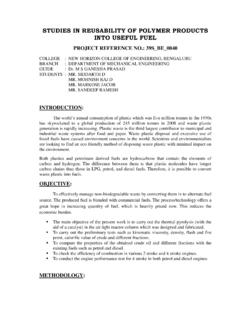Transcription of PLA for Paper Coating - Natur-Tec
1 Paper CoatingPLA for Paper CoatingImproved PLA-Based Compounds Provide a Competitive and Carbon-Neutral Alternative to Polyethylene for Coated Paper Applications Extrusion Coating is an established processing technology result-ing in production of multilayer flexible structures. The operation involves melting of a thermoplastic to be applied onto a substrate such as Paper (as shown in Figure 1). Polyethylene (PE) has been tradi-tionally used for imparting properties such as water & grease resistance to the Paper and in some cases barrier properties. This article discusses the problems and issues arising from a polyethylene coated Paper when biodegraded under composting conditions and the benefits of selecting a fully compostable Coating . CompostabilityCommonly used plastic-coated Paper products include milk and juice cartons, hot and cold Paper drinking cups, frozen food containers, plastic-lined Paper bags, take-out containers and some Paper plates.
2 The issue with plastic coatings such as PE coated products is its end of life what happens to the product after use when it enters the waste/disposal environment Although most of the manufacturers of these plastic-coated Paper products make no claims that their products are compostable, many composters and waste diversion programs accept them either inadvertently assuming there is no polymer in a Paper product or in hopes of composting the Paper fibers along with the Coating . As summarized by Narayan - Chairman of the ASTM Committee for Environmentally Degradable plastics and Biobased Products ( ) [2], to meet the requirements of compostability, a material must satisfy the primary requirements of complete biodegradability under composting conditions. In addition, it has to meet the disintegration and safety criteria to make a claim of compostability.
3 ASTM D6400, D6868, ISO 17055, and EN 13432 are specification standards for compostable plastics and require: 90%+ of the test material s carbon conversion to CO2 via microbial assimilation of the test polymer material in powder, film, or granule form in 180 days or less a laboratory scale test method, as described in the previous section. Disintegration of the test material in both shape and thickness of the products intended for use, such that 90% of the test material must pass through a 2 mm sieve using ISO 16929 or ISO 20200 standard test methods. Safety considerations where the resultant compost should have no impact on plants, using OECD Guide 208, Terrestrial Plants Growth Test. Furthermore, regulated (heavy) metals content in the polymer material should be 50% or lower than prescribed thresholds in the country of use ( , 50% of the , and Canadian Environmental Protection Agency s prescribed threshold).
4 For a 230 gsm (grams per square meter) cupstock Paper having a PE Coating of 15 gsm on one side, the polyethylene content in the product is only However, the specification standard requires that any DieSubstratenipRollLine SpeedChill Rollair grap(not drawn to scale)Figure 1: Schematic of an extrusion Coating process (adapted from reference by B. A. Morris [1])34bioplastics magazine [05/11] Vol. 6 From Science and ResearchBy Shilpa Manjure Natur-Tec A Division of Northern Technologies International Corp. (NTIC) Circle Pines, MN, USAF igure 2: Examples of modified-PLA coated- Paper applications that are certified by the BPI and are fully compostablecomponent added in excess of 1 % to other biodegradable material has to be itself completely biodegradable. PE is not biodegradable and is not completely assimilated by microorganisms in the compost system [2].
5 In fact, PE simply fragments as the Paper is consumed by the microorganisms in the pile. Narayan further [2] reports that the fragments, some of which could be microscopic, can be transported through the ecosystem and could have serious environmental and health recent research from Eco-Cycle and Woods End Laboratories [3] demonstrated and verified that micro- plastics were shed from all plastic-coated Paper products during composting. These micro- plastics may pose a significant risk to our soils, freshwater and marine environments, wildlife, and ultimately, human populations. The Algalita Marine Research Foundation reported [4] that degraded plastic residues can attract and hold hydrophobic elements such as polychlorinated biphenyls (PCBs) and dichlorodiphenyltrichloroethane (DDT) up to one million times the background levels.
6 As such, it is increasingly important that with such a potential threat to our environment we ban non-biodegradable plastic-coated Paper products in compost and practice use of fully compostable coated- Paper (PLA) is the most studied and easily available biobased and biodegradable polymer. As such PLA would be a good candidate to be coated on to Paper for complete compostability at the end of life. PLA, however, has some property drawbacks as discussed later and is not the most suitable candidate for extrusion Coating . This is mostly true when Coating convertors like to utilize their current equipment that has been optimized considering properties and features of polyethylene for the past several decades. PLA properties can be tailored to be coatable and still meet the ASTM D6868, Standard Specification for Labeling of End Items that Incorporate plastics and Polymers as Coatings or Additives with Paper and Other Substrates Designed to be Aerobically Composted in Municipal or Industrial Facilities.
7 This implies that the coated Paper is consumed as food by the microorganisms in the compost pile and there are no fragments of polymer left behind. Both the Paper and Coating are converted completely to carbon dioxide, water and hummus when disposed off in an industrial composting facility [5-7]. Natur-Tec in collaboration with ITC India s Paperboard and Specialty Paper Division [8] has been able to successfully commercialize such a modified-PLA coated Paper that is also certified by the Biodegradable Products Institute (BPI) and convert it to commercial end products as shown in Figure magazine [05/11] Vol. 635 Intrinsic value proposition for using PLA-based coatingsBio-based plastics , in which the fossil carbon is replaced by bio/renewable-based carbon, offer the intrinsic value proposition of a reduced carbon footprint and are in complete harmony with the rates and time scale of the biological carbon cycle.
8 The carbon footprint of biopolymers has been discussed in detail in the recent MRS bulletin [2] by Narayan. Accordingly for every 100 kg usage of petroleum based resins such as polyethylene or polypropylene a net 314 kg of CO2 is released into the environment at the end of cycle. On the other hand if this material is replaced with PLA or Natur-Tec extrusion Coating resin (100% biobased modified-PLA) the net CO2 evolved is zero as all the carbon in this material comes from renewable resources. This is the material carbon footprint of the resin. The other half of the total carbon footprint is the emissions arising from the process of converting the carbon feedstock to product, the impact during product use, and ultimate disposal called the process carbon footprint.
9 Although the process carbon footprint for PLA is higher than PE/PP, the overall CO2 released to the environment, taking into account the intrinsic carbon footprint as discussed above is lower and will continue to get even lower as process efficiencies are incorporated and renewable energy is substituted for fossil energy [2].Figure 4: Elongational viscosity comparison of extrusion Coating grades of (a) polyethylene with (b) modified PLA resin from Natur-Tec . material Carbon Footprint for million sq. mt. of coated paper5045403530252015105zeRO carbon food-print0 PolyethyleneNatur-TecCoating MaterialFigure 3: Material carbon footprint value proposition for Natur-Tec coated Paper compared to PE coated paperTons of CO2 generatedUse of Natur-Tec Coating resin with 100% biobased carbon reduces CO2 emissions by 100% compared to use of petroleum based PlyethyleneFor extrusion coated Paper if we assume that the base Paper used is same and the Coating thicknesses for the PE and Natur-Tec Coating are 15 and 30 gsm respectively, then one can calculate the material carbon footprint.
10 PE contains carbon (0% is biobased) while Natur-Tec resin contains 40% carbon (100% is biobased). So for a million square meter usage one can estimate that the PE Coating will give out tonnes of CO2 while this value will be ZERO for Coating that is renewably resourced as shown in Figure 3. This is a strong value proposition that is environmentally sustainable and intrinsic to the use of biobased Coating lines have a larger air-gap. This is because PE is non-polar and Paper is polar, as such there is little or no adhesion between the thermoplastic and the Paper unless the PE melt flows into the Paper pores or some modification is done to the PE. A solution to this was to let the web of PE melt drop through the air for certain distance causing the hot surface to oxidize slightly creating polar groups that will help in adhesion to the Paper fibers [1,9, 10].







